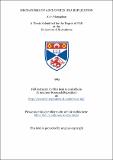Files in this item
Mechanisms of adenovirus DNA replication
Item metadata
| dc.contributor.advisor | Hay, R. T. | |
| dc.contributor.author | Monaghan, Alan | |
| dc.coverage.spatial | 278 p. | en_US |
| dc.date.accessioned | 2018-06-12T09:37:50Z | |
| dc.date.available | 2018-06-12T09:37:50Z | |
| dc.date.issued | 1995 | |
| dc.identifier.uri | https://hdl.handle.net/10023/13935 | |
| dc.description.abstract | The development of a cell-free system in which adenovirus DNA synthesis can be initiated in vitro by using the viral genome or plasmids containing the origin of replication as template has led to the identification of the sequences important for origin function and the isolation and purification of the proteins required for viral DNA replication. In vitro studies on adenovirus types 2 and 5 have shown that their replication requires the formation of a large nucleoprotein complex. This is composed of three virally encoded proteins: adenovirus DNA polymerase, precursor terminal protein and DNA binding protein, and two cellular proteins nuclear factor I and nuclear factor III. While the presence of DNA helicases in other eukaryotic DNA replication systems have been well characterised, this was not the case for adenovirus DNA replication. Initial attempts to identify DNA helicase activity associated with any of the adenovirus replication proteins were unsuccessful. However, a novel DNA unwinding activity was found associated with the DNA binding protein (Ad.DBP). We examined the interaction of DBP with partial DNA duplexes and demonstrated that it could displace oligonucleotides annealed to single-stranded M13 DNA. In addition, DBP could also unwind small fragments of fully duplex DNA. Unlike a DNA helicase, DBP promoted DNA unwinding was nucleoside-5'-triphosphate and Mg2+ independent and exhibited no directionality. The activity required saturating amounts of DBP and was both efficient and cooperative in nature. The helix-destabilising activity was shown to be situated in the C-terminal domain of the protein. These properties suggest a role for DBP in DNA replication in which DBP destabilises duplex DNA during origin unwinding and replication fork movement. The second part of the thesis dealt with the characterisation of the putative "active site" of the adenovirus DNA polymerase. This experimental approach was prompted by data from earlier studies which indicated that DBP could increase the processitivity of the polymerase as well as its sensitivity to nucleotide analogue inhibitors. The "active site" was labelled with pyridoxal-5'-phosphate (PLP), a substrate binding site directed reagent for DNA polymerases. Treatment of Ad.5 DNA polymerase with PLP followed by reduction of the enzyme-PLP adduct resulted in irreversible inactivation of the polymerase activity while the 3'-5' exonuclease associated with Ad.5 DNA polymerase was minimally affected. Substrate protection studies indicate that PLP inhibition is complex. Neither template-primer nor substrate dNTP alone showed any protective effect from PLP mediated inhibition. However, the presence of both template -primer and complementary dNTP significantly protected against PLP inhibition. Comparative tryptic mapping of labelled enzyme, modified in the presence and absence of substrates by PLP reaction, on a C-18 reverse phase column, indicated the protection of one peptide from pyridoxylation in the presence of substrates. Amino acid sequence analyses found no sequence to be present in this peak. | en_US |
| dc.language.iso | en | en_US |
| dc.publisher | University of St Andrews | |
| dc.subject.lcc | QR456.M7 | |
| dc.subject.lcsh | Viral genetics | en |
| dc.title | Mechanisms of adenovirus DNA replication | en_US |
| dc.type | Thesis | en_US |
| dc.contributor.sponsor | Medical Research Council (MRC) | en_US |
| dc.type.qualificationlevel | Doctoral | en_US |
| dc.type.qualificationname | PhD Doctor of Philosophy | en_US |
| dc.publisher.institution | The University of St Andrews | en_US |
This item appears in the following Collection(s)
Items in the St Andrews Research Repository are protected by copyright, with all rights reserved, unless otherwise indicated.

